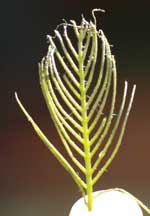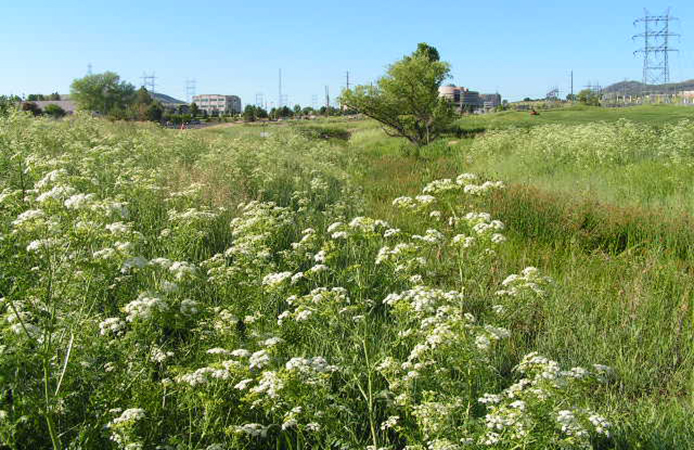Eurasian watermilfoil
Myriophyllum spicatum
Keys to Identification
Family
Water Milfoil (Halorgaceae)
USDA Code
MYSP2
Legal Status
Colorado List B Noxious Weed
Identification
Lifecycle
Submersed perennial
Growth form
Herb
Flower
Tiny pink, usually flower in mid to late July.
Seeds/Fruit
Many seeds produced, not a factor in reproduction.
Leaves
Leaves are divided into leaflets that are threadlike, usually in more than 14 pairs.
Stems
Long underwater stems that are branched which produce leaves near the surface of the water.
Roots
Plants die back to root crowns in fall, sprouting in spring.
Seedling
Rare, never observed occurring naturally.
Colonization
New colonies are usually a result of fragmentation. The plant can auto-fragment, producing roots before separation. Activities such as boating and natural processes such as wind and wave action can also cause fragmentation. Each fragment can become a new plant.
Similar Species
Natives
Native milfoil
Impacts
Agricultural
Dense mats clog waterways.
Ecological
Growth of the thick vegetative mats degrade water quality and reduce dissolved oxygen levels. Dense mats can restrict recreation and can foul beaches when the mats begin to decay.
Habitat and Distribution
General requirements
Lakes, ponds, shallow reservoirs and low energy areas of rivers and streams.
Distribution
Confirmed in 45 states and in Canada.
Historical
Native range was Europe, Asia, and northern Africa. First documented in the US in 1942, thought to have been intentionally introduced.
References
Couch, R., and E. Nelson. 1985. Myriophyllum spicatum in North America. Pp. 8-18 in L.W.J. Anderson (ed.). First International Symposium Watermilfoil and Related Haloragaceae Species. 23-24 July 1985, Vancouver , B.C. Aquatic Plant Management Society, Vicksburg, MS
Madsen, J.D., J.W. Sutherland, J.A. Bloomfield, L.W. Eichler, and C.W. Boylen. 1991. The decline of native vegetation under dense Eurasian watermilfoil canopies. J. Aquatic Plant Management 29:94-99.
Nichols, S. A. 1975. Identification and management of Eurasian Water Milfoil in Wisconsin. Wisconsin Academy of Sciences, Arts and Letters 63:116-126.
Nichols, S. A. 1994. Evaluation of invasions and declines of submersed macrophytes for the Upper Great Lakes Region. Lake and Reservoir Management 10(1):29-33.



